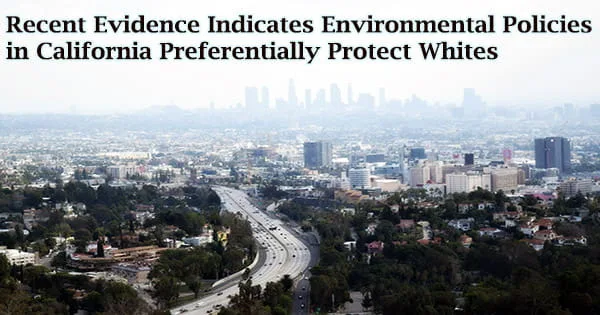According to recent research from the University of California San Diego’s School of Global Policy and Strategy, Asian and Hispanic areas in the state of California suffer much greater air pollution from economic activity than neighborhoods with a higher percentage of white residents.
According to a study that was published in the journal Nature Sustainability, the environmental laws of California as a whole preferentially shield the state’s white, non-Hispanic residents from exposure to air pollution.
The study concentrated on 2020 when COVID-19-related shelter-in-place orders were issued by the state. The researchers used data from publicly and privately owned air monitor networks, as well as satellite measurements of the pollutant gas nitrogen dioxide, to analyze patterns of air pollution both before and during the shutdown.
The researchers discovered that during the time when the “in-person” economy was shut down, neighborhoods with high Asian and Hispanic populations experienced disproportionately large declines in air pollution after taking into account various factors, including the extent to which communities were sheltering in place. That implies that while things are running well, the opposite is true.
They also discovered that during the shutdown, Black communities didn’t experience the same disproportionate improvement in air quality. When only vital businesses were open during the shutdowns, black Californians were subjected to higher pollution levels than whites.
After COVID-19 restrictions were relaxed, the same held true. This shows that these populations are routinely exposed to filthy air because of power plants, energy generators, and other emission sources that were not restricted under shelter-in-place orders.
The study also reveals that low-income areas routinely experience higher pollution levels while the economy is booming and that the closure significantly improved air quality in these areas. However, even after taking into account income in their analyses, the researchers still couldn’t explain why Asian and Hispanic populations across the state were exposed to greater levels of air pollution.
“Income only explains about 15 percent of the disproportionate decrease in air pollution experienced by Asian and Hispanic communities during the shutdown,” said Jennifer Burney, the Marshall Saunders Chancellor’s Endowed Chair in Global Climate Policy and Research at the School of Global Policy and Strategy.
“This may be surprising to many because people tend to conflate income and race, both because systemic discrimination is a hard thing to face and because we have accepted that we live in a world where individuals can ‘buy’ cleaner air through higher housing prices in less polluted areas.”
One would think that in a state with strong environmental policies, where we track what is being emitted where, our regulatory system might do a good job of protecting everyone equally. But this is really strong evidence of systemic bias. Pollution sources from everything that was shut down, transportation, businesses, restaurants, etc. all add up during business-as-usual conditions. Thus, the total system is tipped, exposing racial and ethnic minorities to more pollution.
Jennifer Burney
Burney added, “the COVID shutdown gave us a window into what pollution patterns look like when most of the economy is turned off and it showed that though there is some small overlap, income does not explain the racial and ethnic bias in how our economy creates and distributes pollution.”
This, according to Burney and the study group, is proof that environmental policies have failed. Transportation, energy, construction, and other industries must adhere to high environmental regulations in California since all emissions are regulated.
“One would think that in a state with strong environmental policies, where we track what is being emitted where, our regulatory system might do a good job of protecting everyone equally,” Burney said.
“But this is really strong evidence of systemic bias. Pollution sources from everything that was shut down, transportation, businesses, restaurants, etc. all add up during business-as-usual conditions. Thus, the total system is tipped, exposing racial and ethnic minorities to more pollution.”
The effects of poor air quality on health are extensive. Higher rates of newborn and adult mortality, as well as respiratory and cardiovascular diseases, are associated with unhealthy air.
Policy recommendations to address systemic environmental racism
Despite the study’s limitations, the researchers think that additional states are likely affected by the variation in air quality between racial groups. The report contains a number of policy suggestions.
For instance, since transportation accounted for the majority of the pollution affected by the pandemic’s slowdown, measures that affect transportation emissions may have significant effects on California’s disadvantaged populations.
Furthermore, since wealth does not account for the gaps in air pollution that racial and ethnic minorities experience, environmental solutions focused solely on money cannot be anticipated to achieve significant racial and ethnic fairness. This shows that in order to fulfill average environmental requirements and promote justice, various metrics should be taken into account while considering environmental rules.
“There is no clear, quantitative equity criterion applied in regulatory analysis to safeguard against environmental racism,” said co-author Katharine Ricke, an assistant professor at the School of Global Policy and Strategy and Scripps Institution of Oceanography.
“For example, if an industry wants to build a factory, they have to complete an environmental assessment report, but that report isn’t required to include a set of metrics to demonstrate how different demographic groups nearby would be affected. If industries had to run atmospheric models to show that the proposed facility is not going to disproportionately affect minority neighborhoods nearby, that could instigate a significant shift in making environmental regulation more equitable.”
The authors also advise involving local populations in the planning stage if environmental changes are being considered that could have an influence on air quality.
“This is not new, but procedural justice is also critical,” said co-author Pascal Polonik, a Ph.D. candidate at Scripps Oceanography. “Communities need to be engaged in meaningful ways to ensure that everyone has access to what should be a democratic process.”
Polonik added that, “by improving access to information, such as data from the crowd-sourced sensors that were utilized in the study, could help communities be part of informed decision-making. Unfortunately, these sensors tend to be located in the places least likely to be impacted by unjust pollution exposure.”
Other paper authors include Richard Bluhm, assistant professor at Leibniz University Hannover and fellow in the Department of Political Science at UC San Diego; Kyle S. Hemes, postdoctoral research fellow at Stanford Woods Institute for the Environment; Luke C. Sanford, assistant professor at Yale University’s School of the Environment; Susanne A. Benz, postdoctoral fellow at Dalhousie University; and Morgan C. Levy, assistant professor at the School of Global Policy and Strategy and Scripps Institution of Oceanography.
















